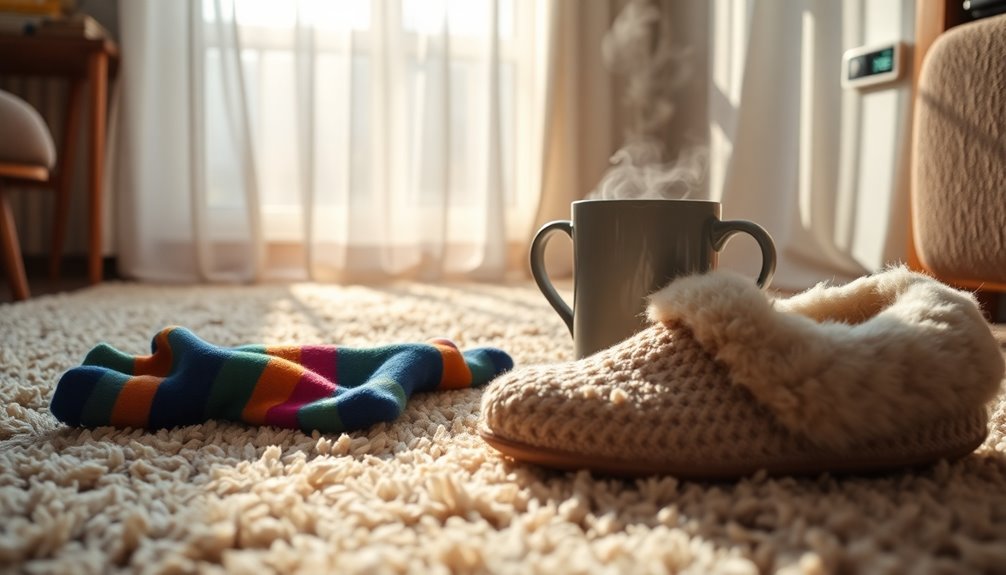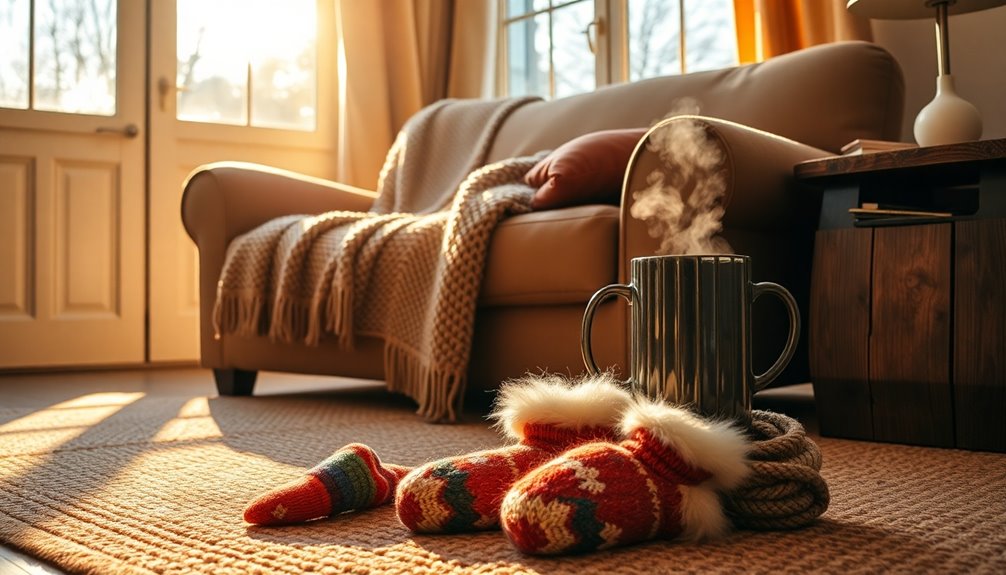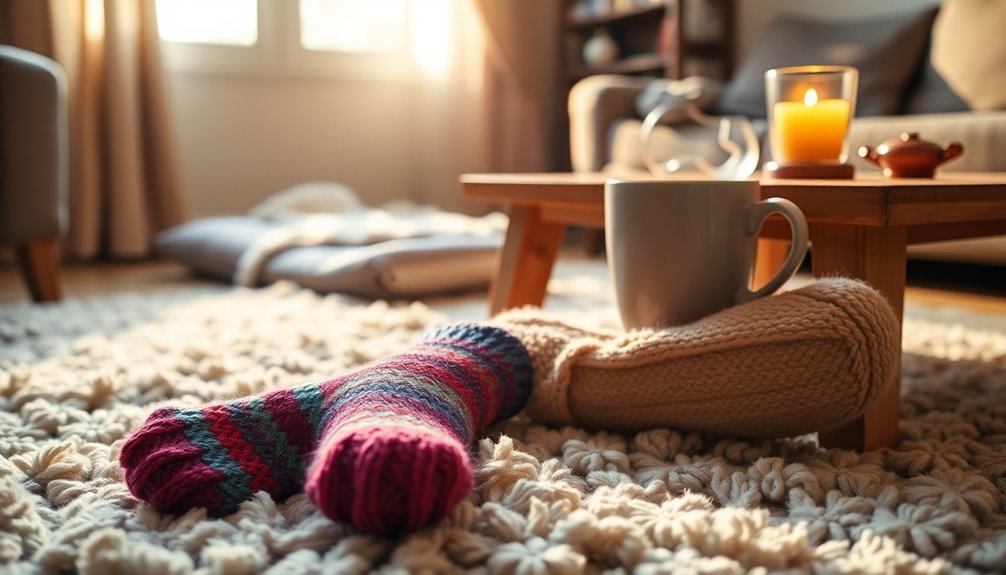When it comes to frugal heating, wearing thermal socks is often a better choice than slippers. Socks retain body heat efficiently and improve circulation, helping you stay warm without the extra cost. They're also safer on smooth surfaces, reducing the risk of slips. On the other hand, slippers provide cozy insulation and support but can be pricier. Layering socks can enhance warmth, making them a versatile and budget-friendly option for chilly days. Curious about ideal combinations and tips for keeping your feet warm? You might find some useful strategies worth exploring!
Benefits of Wearing Socks
When it comes to comfort during colder months, the simple act of wearing socks can make a significant difference. By wearing socks, you help retain body heat, trapping warmth around your feet, which are often a major source of heat loss. Thick socks made from materials like wool offer superior insulation, ensuring you stay cozy even on the coldest days. Additionally, using budget apps can help you manage expenses related to heating, ensuring you maintain comfort without overspending. Incorporating effective expense tracking can further assist in keeping your heating costs manageable.
Not only do socks keep you warm, but they also improve blood circulation in your feet. This is vital for preventing cold-related discomfort and potential health issues.
Plus, choosing socks over slippers is an affordable alternative, allowing you to save money while still enjoying warmth and comfort.
Moreover, wearing socks can reduce slips and falls on smooth surfaces typically found in homes. This added safety is especially important during the cold months when the risk of accidents can increase.
With all these benefits, it's clear that thick, warm socks are an essential part of your winter wardrobe. Additionally, wearing socks while shopping for winter essentials can enhance your experience by allowing you to better gauge the fit and comfort of potential purchases, leading to more informed shopping decisions with personalized recommendations. So, the next time you feel a chill, remember that wearing socks can enhance your comfort, keep you safe, and save you money.
Advantages of Slippers
Slippers offer a cozy alternative to socks, providing a thicker layer of insulation that helps retain body heat more effectively. When you put on slippers, you'll immediately notice the warmth enveloping your feet, especially on cold floors like tile or hardwood, which can chill your body temperature. The added insulation keeps your feet toasty, making slippers a great choice for chilly indoor environments. Additionally, implementing clear payment terms can enhance your overall comfort by reducing financial stress during colder months.
Many slippers feature cushioned insoles and arch support, enhancing comfort for prolonged wear. This extra support is particularly beneficial if you spend a lot of time on your feet. Furthermore, wearing slippers can contribute to financial well-being by reducing the need for excessive heating when you're comfortably bundled up at home.
Plus, with rubber soles, slippers provide excellent traction on slippery surfaces, reducing the risk of falls and injuries around your home.
Moreover, certain slippers are crafted from moisture-wicking materials like wool or fleece, ensuring your feet stay dry and comfortable while enjoying that much-needed warmth.
By wearing slippers, you not only protect your feet from cold floors but also enjoy a snug, supportive fit that socks simply can't match. Additionally, investing in efficient financial management practices can help you save on heating costs and keep your home comfortable.
Cost Comparison of Socks vs. Slippers

Choosing between socks and slippers often comes down to cost, and it's clear that socks usually win this round. Socks are generally more affordable, with prices ranging from $5 to $20, while slippers can set you back $15 to $50.
If you're looking for warmth, thermal or wool socks are excellent at retaining body heat, often outperforming many slippers in insulation effectiveness. Additionally, using budgeting apps can help you track your spending on these items and ensure you stay within your financial means. Many of these tools also offer automated features that can simplify your overall financial management.
While slippers do offer additional support and cushioning, which can be helpful for foot pain, that benefit may not justify the higher price tag. If you're frugal, you'll appreciate that socks can be layered with other clothing, increasing their versatility for overall body warmth. This makes them a cost-effective choice compared to single-use slippers.
For households with multiple occupants, buying socks in bulk can lead to significant savings. You can share them easily, unlike slippers, which are often personal items.
In the cost comparison of socks versus slippers, not only do socks come out cheaper, but they also provide a practical solution for maintaining warmth without breaking the bank. Additionally, employing budgeting tools can help you manage your finances more effectively while making these purchases. So, if you're looking for affordability and efficiency, socks are the way to go.
Layering for Extra Warmth
Layering socks is an effective strategy for maximizing warmth during colder months. By wearing thermal or thick socks, you can trap body heat and greatly enhance your comfort level.
If you add slipper socks on top, you'll get double the insulation, minimizing heat loss from your feet. This combination is particularly effective in colder indoor environments.
Choosing looser-fitting socks allows for better circulation, which helps maintain warmth compared to tighter footwear that can restrict blood flow. Additionally, wearing socks made from sustainable materials contributes to reducing your environmental footprint while keeping your feet warm.
Opt for fleece-lined or wool socks, as these materials naturally retain heat and wick moisture away from your skin, keeping your feet dry and cozy. Additionally, selecting materials that are sourced sustainably can contribute to reducing textile waste in the fashion industry.
Don't forget about slippers! Combining socks with cozy slippers guarantees your feet are fully covered, preventing cold air from seeping in.
This base layer of warmth can make all the difference in how comfortable you feel at home. Additionally, ensuring that your home is well-insulated can further enhance your warmth and reduce energy consumption, supporting sustainable practices in your living environment.
Keeping Your Feet Cozy

Keeping your feet cozy is essential for staying warm during chilly days at home. You'll want to maximize heat retention and comfort, so consider your options wisely.
While slippers can provide some warmth, thick, well-fitting socks—especially thermal socks made from wool or fleece—are often superior for insulation. They trap warmth close to your skin, ensuring your feet stay toasty. Utilizing coupon codes when shopping for socks can also help you save money on your purchases. Additionally, investing in quality socks can lead to improved comfort and durability, much like the expense tracking solutions freelancers utilize for better financial management.
Here are three effective strategies for keeping your feet cozy:
- Opt for Thermal Socks: Choose socks made from materials like wool or fleece, which offer excellent insulation and warmth.
- Layer Wisely: Wear thin moisture-wicking socks underneath thicker insulated ones. This layering technique enhances warmth without compromising comfort.
- Try Slipper Socks: Consider slipper socks that blend the benefits of both socks and slippers. They provide cozy warmth while offering traction for safe movement indoors. Additionally, you can further enhance your comfort by utilizing digital coupons to find great deals on cozy footwear options.
Maintenance and Care Tips
To enjoy the warmth and comfort of your socks and slippers for longer, proper maintenance is key. Regularly wash your socks and slippers according to their care instructions. Machine-washable options are often more convenient and help maintain hygiene while prolonging their lifespan.
Inspect your slippers for wear and tear, and replace them when the soles become thin or the insoles lose support. Proper footwear greatly enhances warmth and comfort indoors.
It's also a good idea to rotate between several pairs of socks and slippers. This allows each pair to air out, helping to reduce odor and extend their usability.
When choosing socks, opt for high-quality materials like wool or thermal fabrics, and select slippers with good insulation and moisture-wicking properties. These choices maximize warmth and comfort.
Finally, store your socks and slippers in a dry, cool place. This helps prevent mold and odor growth, ensuring they remain fresh for use during colder months.
Creative Alternatives for Warmth

How can you stay warm without cranking up the heat? You can turn to some creative alternatives that allow you to maintain comfort while keeping your heating costs low. Here are three effective options:
- Layer Up with Thermal Socks: Invest in thermal socks designed to trap warmth better than regular cotton. They'll help retain your body temperature, ensuring your feet stay cozy even in the cold.
- Choose Insulated Slippers: Opt for slippers with insulated linings. They provide extra warmth and let you move around easily, perfect for chilly indoor temperatures. Look for those with rubber soles to block cold air from the floor.
- Combine Socks and Slippers: For maximum warmth, wear thick socks inside your cozy slippers. This combination enhances insulation, allowing you to stay warm without needing to raise the thermostat.
These budget-friendly options not only keep you from feeling cold but also help you save on heating costs.
Community and Sharing Ideas
Amid the chill of winter, tapping into community resources can make a significant difference in your heating strategy. By engaging in discussions with neighbors, you can share tips on staying warm and discover innovative winter heating strategies.
Local community centers often provide warm spaces where you can gather, exchange ideas, and receive assistance during extreme cold temperatures.
Consider collaborating with neighbors for bulk purchases of heating supplies; this not only reduces costs but also fosters a sense of solidarity in facing winter challenges together.
Libraries and public facilities serve as accessible warm spaces, allowing you to save on home heating costs while enjoying educational opportunities and social interaction.
Sharing personal experiences and frugal living tips within your community can inspire others to adopt cost-effective solutions.
By building a supportive network, you strengthen your community's resilience against the cold.
Remember, the more you connect and collaborate, the warmer your winter will be. Embrace the power of community, and you'll find that staying warm doesn't have to break the bank.
Together, you can create a winter season filled with comfort and camaraderie.
Conclusion
So, whether you choose socks or slippers, just remember: your feet deserve to be pampered while you save on that heating bill. After all, who needs fancy heating when you can rock a pair of mismatched socks or those slightly embarrassing slippers? Embrace the frugality, and let your feet start a fashion revolution in your living room. Because nothing says "I'm saving money" quite like a cozy pair of socks paired with your best lounge pants!



